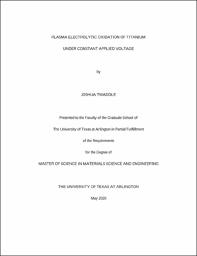
ATTENTION: The works hosted here are being migrated to a new repository that will consolidate resources, improve discoverability, and better show UTA's research impact on the global community. We will update authors as the migration progresses. Please see MavMatrix for more information.
Show simple item record
| dc.contributor.advisor | Meletis, Efstathios | |
| dc.creator | Twaddle, Joshua Paul | |
| dc.date.accessioned | 2020-06-15T14:36:35Z | |
| dc.date.available | 2020-06-15T14:36:35Z | |
| dc.date.created | 2020-05 | |
| dc.date.issued | 2020-06-08 | |
| dc.date.submitted | May 2020 | |
| dc.identifier.uri | http://hdl.handle.net/10106/29141 | |
| dc.description.abstract | Plasma Electrolytic Oxidation (PEO) is a method capable of applying nonmetallic coatings to metallic substrates submerged in electrolyte via a plasma development under high voltage. The PEO technique is particularly useful in the coating of materials such as Ti-, Al-, and Mg-based alloys. In this study, the effects of varying processing voltage and time on oxide coating characteristics formed on pure titanium surfaces was investigated.
First, it was necessary to prove that the selected electrolyte type and concentration could produce PEO coatings in a predictable fashion. Experiments were performed with constant current density by constantly controlling the voltage, so the results could be compared to previous experiments performed on the same substrate. It was discovered that the new electrolyte produced arcing, having an adverse effect on coating quality. A similar relationship between current density and time was observed, as in the previous experiments, so it was concluded that the new electrolyte was adequate. Experiments were then performed at a wide voltage range with the voltage being manually increased to and then held constant at certain values to observe the current density behavior. These observations indicated that current density remains high early in the process where high voltage values prevail, and then decays quickly (almost to zero). Thus, a higher initial voltage leads to longer processing times before the current dies out. It was hypothesized that the amount of charge (current density x time) is indicative of coating thickness. As shown in previous works, the coating thickness is dependent on the ionic current applied to the sample, which makes up only part of the total current density. This ionic current makes up no more than half of the total current density, and decreases to zero at current densities below 30 mA/cm2. Through these experiments it was discovered that a higher operating potential allowed for continued ionic current application for longer time spans during processing. For this reason, a potential of 450 V was selected for continued experiments. Several methods of characterization were used to identify the effects of varying processing voltages and processing time on the roughness, morphology, composition, and thickness of the applied oxide coating. Processing voltage was found to be the only characteristic that effected coating thickness, and processing time was found to only have a pronounced effect on the composition of the coating while the other characteristics remained unchanged. Through this project, it was discovered that using the constant voltage method of PEO, the maximum amount of ionic current that can be applied (and therein the maximum coating thickness) can be reached within a minute of processing. The changes in coating composition as a function of coating thickness were also determined. | |
| dc.format.mimetype | application/pdf | |
| dc.language.iso | en_US | |
| dc.subject | PEO Plasma Electrolytic Oxidation Titanium Coating Titanium Oxide Mechanism | |
| dc.title | Plasma Electrolytic Oxidation of Titanium Under Constant Applied Voltage | |
| dc.type | Thesis | |
| dc.degree.department | Materials Science and Engineering | |
| dc.degree.name | Master of Science in Materials Science and Engineering | |
| dc.date.updated | 2020-06-15T14:36:35Z | |
| thesis.degree.department | Materials Science and Engineering | |
| thesis.degree.grantor | The University of Texas at Arlington | |
| thesis.degree.level | Masters | |
| thesis.degree.name | Master of Science in Materials Science and Engineering | |
| dc.type.material | text | |
| dc.creator.orcid | 0000-0002-6531-3003 | |
Files in this item
- Name:
- TWADDLE-THESIS-2020.pdf
- Size:
- 7.087Mb
- Format:
- PDF
This item appears in the following Collection(s)
Show simple item record


